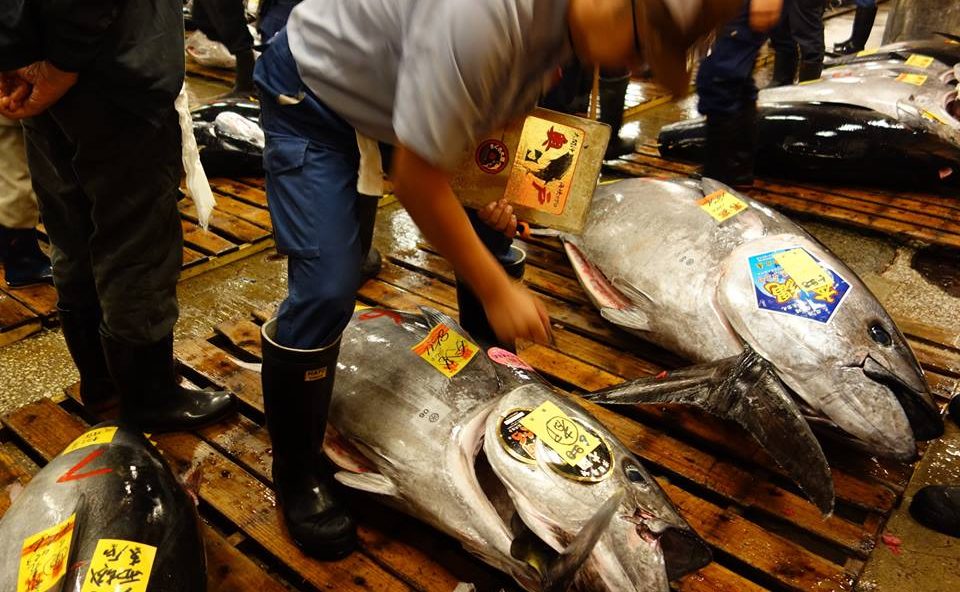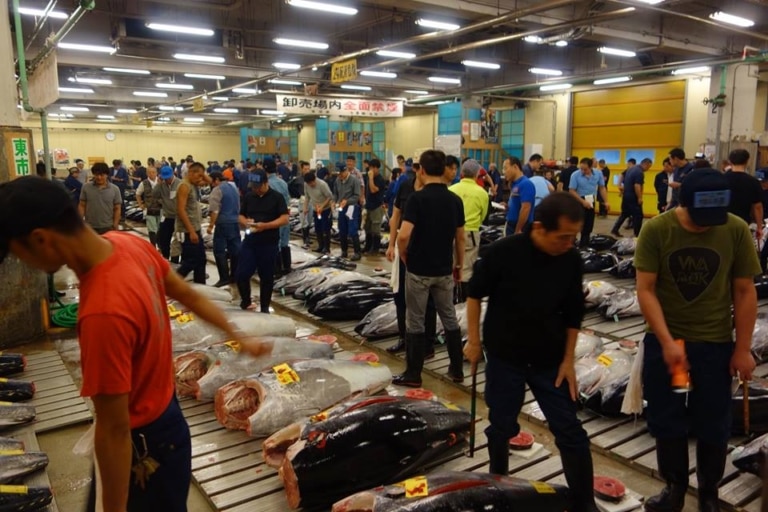
$1.8M Tuna to “Affordable” $1 Tuna Sushi—The Mystery of Japanese Tuna Industry
A few days after the new year’s excitement and festivities subside, there is always the same news in Japan which draws world-wide attention—, The very first tuna auction of the year.
2013 was a remarkable year. A 222kg bluefin tuna from the northern tip of mainland Japan was sold for $1.8M. That is over $8,000/kg! The bluefin tuna was bid on by the “great king of maguro (tuna)”, Kiyoshi Kimura, the president of nationwide sushi restaurant chain Sushi Zanmai (means sushi indulgence).

Early morning in Tsukiji fish market.
The bluefin tuna from the northern tip of the mainland of Japan, Ohma, is called “black diamond” among the fishermen. Ohma bluefin is caught one by one using single-hook pole-and-line, and is known for its juicy fatty taste, freshness, and quality. In fact, it is the most expensive bluefin tuna in the world.
The fierce tuna bidding battle began in 2008, when Hong-Kong based sushi restaurant chain, Itamae Sushi, entered the auction, setting the stage for a battle between its owner Ricky Chen and Kimura. The price of the best tuna from the first auction of the year steadily increased until it finally hit $1.8M in 2013.
It is common in Japan that the first auction of the season tends to be outrageously priced due to a custom called goshugi-souba, which means “gift money price.” The winning bidder often says they are encouraging the market. However, it is obvious that it has more of a marketing impact than pure encouragement. In fact, the rival of Kimura admitted that it was clash of wills, and Kimura, the great king of maguro, has been dominating the auction ever since.
While the fierce bidding war is on the news, most middle class families enjoy affordable running sushi, also as known as conveyor belt sushi. The color of the plate represents the price of the sushi, usually 2 pieces on each plate. Prices typically range between 100 and 400 yen per plate, while some chain restaurants offer an all plates, including tuna, at a bargain 100 yen deal, about one dollar at the time of this blog.
The question arises. Where are the cheap tuna coming from? In 2014, the average wholesale price of bluefin tuna was 2,000 yen/kg, which was twice as much as other tuna species such as bigeye (1,000 yen/kg), yellowfin and albacore (about 300~400 yen /kg). Those relatively cheap tuna are often used by the chain restaurants. Although bluefin tuna is Japanese luxury food with its juicy, flavorful fatty meat that melt in your mouth, those cheap tuna are just as good. Flavorful red lean meat is nothing like other fish. Sushi chef often add twists to those tuna by searing the surface to bring out the fatty flavor, marinating with soy sauce, and adding topping such as mayonnaise, grated daikon radish and other vegetables. Their creativity is eye opening, and that is one of the best parts of eating sushi in Japan.
Although Japan is surrounded by the ocean, its tuna industry heavily depends on imports. In 2014, Japan consumed 385,000 tons of tuna, of which 47.5% (183,000 tons) of the total consumption was imported, and 90% of the imports (166,500 tons) was those cheap tuna.
The 2015, International Seafood Sustainability Foundation (ISSF), a science-based third-party watchdog for tuna stock management, reported on the stock status of tuna in the world. According to the report, 43% of tuna came from healthy stock, however, 38% of tuna came from already overfished stock. ISSF report also showed that most of these tuna are caught by longline and purse-seine net which brings bycatch of many endangered species such as sharks, albatrosses and sea turtles.
Tuna increases exponentially in value as it grows in size. The profit-driven, short-sighted fishing industry diminished the stocks of the world’s largest tuna. Bluefin tuna stocks were affected first, driving them to an endangered species by continuing to harvest pre-spawn small juveniles, eliminating their chance to reproduce. Then the fishing pressure simply moved down to bigeye, the next largest tuna, collapsing half of the stocks already. Scientists are worried that in the course of time, tuna stocks will be stripped in the order of bigeye, yellowtail, and then albacore, decimating its value in market. If the industry continues on this path, we might see a world where tuna just means albacore.
Historically, tuna was always considered a delicacy in Japan. However, in the course of the development of fishing method and transportation tuna became very popular and affordable. Uninformed consumers are simply taking it granted to enjoy the cheap prices on them. Some research suggests that Japan consumes up to 80% of the world’s tuna. Do we, Japanese, want to eat all the tuna in the ocean until it is gone forever? Unfortunately, it does not seem that Japanese society understands the urgency of the crisis quite yet.
reference: ISSF TUNA STOCK STATUS UPDATE 2015, FAO Global Capture Production 1950-2014, Ministry of Agriculture, Forestry and Fisheries Japan





